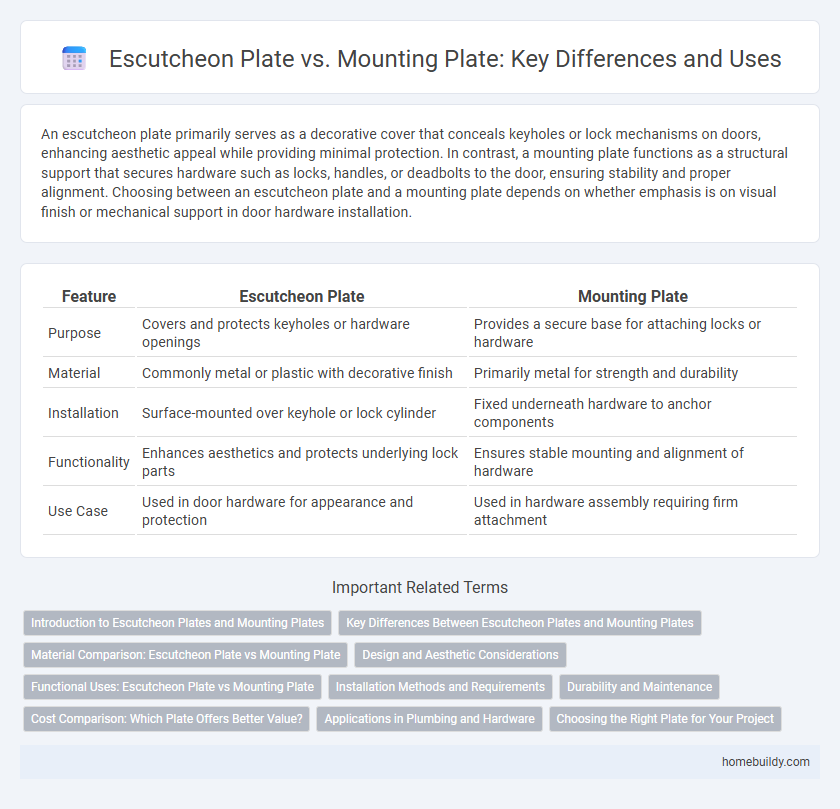An escutcheon plate primarily serves as a decorative cover that conceals keyholes or lock mechanisms on doors, enhancing aesthetic appeal while providing minimal protection. In contrast, a mounting plate functions as a structural support that secures hardware such as locks, handles, or deadbolts to the door, ensuring stability and proper alignment. Choosing between an escutcheon plate and a mounting plate depends on whether emphasis is on visual finish or mechanical support in door hardware installation.
Table of Comparison
| Feature | Escutcheon Plate | Mounting Plate |
|---|---|---|
| Purpose | Covers and protects keyholes or hardware openings | Provides a secure base for attaching locks or hardware |
| Material | Commonly metal or plastic with decorative finish | Primarily metal for strength and durability |
| Installation | Surface-mounted over keyhole or lock cylinder | Fixed underneath hardware to anchor components |
| Functionality | Enhances aesthetics and protects underlying lock parts | Ensures stable mounting and alignment of hardware |
| Use Case | Used in door hardware for appearance and protection | Used in hardware assembly requiring firm attachment |
Introduction to Escutcheon Plates and Mounting Plates
Escutcheon plates serve as decorative covers that conceal screw holes and protect door hardware, enhancing both aesthetics and function. Mounting plates provide structural support by securely fastening hardware components to surfaces, ensuring stability and alignment. Understanding the distinction between escutcheon plates and mounting plates is essential for selecting appropriate door accessories in construction and hardware installation.
Key Differences Between Escutcheon Plates and Mounting Plates
Escutcheon plates serve primarily as decorative covers for keyholes or pipe penetrations, enhancing aesthetic appeal and protecting the underlying surface. Mounting plates, on the other hand, provide structural support, securing hardware fixtures firmly to walls or doors. The key difference lies in functionality: escutcheon plates focus on concealment and design, whereas mounting plates emphasize durability and load-bearing capacity.
Material Comparison: Escutcheon Plate vs Mounting Plate
Escutcheon plates are typically crafted from decorative metals such as brass, stainless steel, or chrome-plated zinc, offering both aesthetic appeal and corrosion resistance. Mounting plates prioritize strength and durability, often made from heavy-gauge steel or aluminum to support structural loads and secure hardware firmly. The material choice directly influences the escutcheon plate's role in enhancing visual design, whereas mounting plates emphasize robust mechanical performance.
Design and Aesthetic Considerations
Escutcheon plates feature sleek, decorative designs that seamlessly integrate with door hardware, enhancing the overall aesthetic appeal while concealing keyholes or fasteners. Mounting plates prioritize structural support with simpler, utilitarian designs that may not contribute significantly to visual appeal. Choosing an escutcheon plate elevates interior design by combining functionality with ornamental value, whereas mounting plates focus primarily on stability and installation ease.
Functional Uses: Escutcheon Plate vs Mounting Plate
Escutcheon plates provide a decorative cover for keyholes, door knobs, or lock cylinders, enhancing aesthetic appeal while protecting the surrounding surface from wear or damage. Mounting plates serve as structural backings that securely fasten hardware such as locks, hinges, or electronic components, ensuring stability and proper alignment. The functional difference lies in escutcheon plates focusing on surface protection and ornamental value, whereas mounting plates prioritize hardware support and installation integrity.
Installation Methods and Requirements
Escutcheon plates typically require surface mounting directly onto doors or walls, emphasizing precise alignment with the keyhole or lock cylinder, whereas mounting plates often involve embedded installation to support hardware like locksets or handles. Installation of escutcheon plates demands accurate measurement to ensure flush fitting and aesthetic appeal, while mounting plates must be securely fastened with screws or bolts to withstand operational stress. Proper sealing and compatibility with door thickness are critical for escutcheon plates, contrasting with mounting plates that prioritize structural stability and load-bearing capacity.
Durability and Maintenance
Escutcheon plates are typically crafted from durable metals like stainless steel or brass, offering superior resistance to corrosion and wear compared to standard mounting plates. Their robust design reduces the need for frequent maintenance, ensuring long-lasting performance in high-traffic or outdoor environments. Maintenance for escutcheon plates generally involves simple cleaning and occasional polishing, whereas mounting plates may require more frequent inspections and replacements due to less durable materials.
Cost Comparison: Which Plate Offers Better Value?
Escutcheon plates generally offer a more affordable option compared to mounting plates due to simpler design and easier installation requirements, reducing labor costs. Mounting plates, while typically pricier, provide enhanced stability and compatibility with a wider range of hardware, potentially lowering long-term maintenance expenses. Evaluating immediate cost savings against durability and functionality helps determine which plate delivers better overall value for specific projects.
Applications in Plumbing and Hardware
Escutcheon plates are primarily used in plumbing to cover pipe penetrations and provide a clean, finished look around faucets, valves, and showerheads, ensuring protection against water damage and debris intrusion. Mounting plates, by contrast, serve as structural supports for hardware installations, securing fixtures such as door handles or electrical components without emphasis on aesthetic coverage. Both escutcheon and mounting plates are essential in hardware applications, where the escutcheon enhances visual appeal and sealing while mounting plates offer stability and alignment for fixtures.
Choosing the Right Plate for Your Project
Escutcheon plates provide a decorative finish that conceals gaps around door hardware, enhancing aesthetic appeal, while mounting plates primarily offer structural support for securing locks or handles. Selecting the right plate depends on whether your project prioritizes visual refinement or reinforces hardware stability. For a seamless look with reliable attachment, combining escutcheon plates with compatible mounting plates is often the best solution.
escutcheon plate vs mounting plate Infographic

 homebuildy.com
homebuildy.com